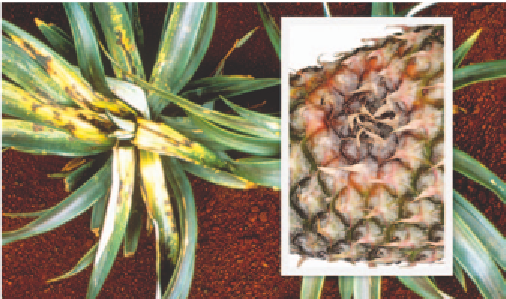Agriculture Reference
In-Depth Information
Importance
The disease is widely distributed in Queensland pineapple
plantations. The incidence is variable and sometimes high.
The amount of wilt in a field is related to the number of
mealybugs present, the length of time they feed and the
activity of ants.
Management
•
Use planting material from wilt-free areas or from fi elds
with a low level of wilt disease. If less than 3% of plants
show wilt symptoms, remove infected plants by hand
and destroy them.
Fig 16.28 Mealy bug wilt damage on pineapple plants in the
foreground, which are surrounded by healthy plants.
Use recommended insecticides for mealybug and ant
control where more than 3% of plants show wilt symptons.
•
Symptoms
The early symptoms are a slight reddening of leaves about
halfway up the plant. The leaf colour then changes from
red to pink and leaves lose rigidity, roll downwards at the
margin and the tip of the leaf dies. The root tissue also
collapses and the plant appears wilted. Plants can recover
to produce symptomless leaves and fruit that are markedly
smaller than fruit from healthy plants.
If more than 10% of plants show wilt symptoms, do not
use the fi eld as a source of planting material.
•
Eradicate badly affected areas immediately after harvest.
•
Keep headlands and fi eld boundaries free from weeds and
rubbish as these may act as reservoirs for ants and mealy
b u g s .
•
Symptoms are most obvious in winter when plant growth
and vigour are reduced.
Disease development and incidence is affected by plant age
at the onset of mealybug infestation, with younger plants
displaying symptoms two to three months following
feeding, while older plants may take up to 12 months to
develop symptoms.
YELLOW SPOT
■
Cause
Tomato spotted wilt virus, Capsicum chlorosis virus
(Tospoviruses).
Symptoms
Infection occurs on young crowns when they are still on
the fruit or during the first few months after planting.
Small (2-5 mm), round, yellow spots appear on the upper
surface of the leaves of young plants. These spots fuse and
form yellow streaks in the leaf tissue, which soon becomes
Source of infection and spread
The disease is thought to be caused by viruses transmitted
by mealybugs with the pink mealybug (
Dysmicoccus
brevipes
) being the main vector in Queensland. The disease
is probably introduced in planting material that may not
show obvious disease symptoms.
Once established, the viruses are transmitted when the
mealybugs feed on young leaves. Mealybugs are sedentary
insects that are moved from plant to plant by attendant
ants or by wind. Ants actively tend mealybugs. The coastal
brown ant (
Pheidole megacephala
) is common and active in
pineapple plantations, but many other species can be
involved in raising mealybugs. Mealybugs produce
honeydew, which is harvested by ants for food. Ants also
protect mealybugs from predators and move them around
and between plants. The removal of spiders from fields by
ants often allows large populations of mealybugs to
develop, increasing the risk of severe mealybug wilt
outbreaks.
Fig 16.29 Yellow spot symptoms on pineapple.













